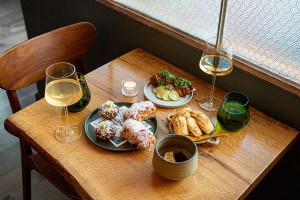Dinner At The Fish Riot: Royal Sushi And Izakaya Reviewed
There are restaurants you go to because you’re hungry, and restaurants you go to because they’re cool. There are restaurant you go to because they’re close—the old soldiers of your particular block, with rooms as comfortable as faded blue jeans and a bartender who knows your name. And then there are restaurants you go to because they make you feel better about your neighborhood, your city or yourself. That’s what Royal Sushi and Izakaya is for me.
As a city, Philly has gone through a remarkable restaurant boom. Over the past few years, we’ve seen a series of fast upward spikes in our culinary bar graph—the openings of restaurants that can stand toe-to-toe with the best anywhere, awards brought home by our best chefs, and the development of a style (iconoclastic, collaborative, with a Continental inflection but a solidly DIY blue-collar heart) that’s recognizably our own.
But lately there’s been a noticeable staling of the rarefied air we’ve been breathing for the past two or three or four years—an exhaustion wheezing at the edges of things. I’ve spent too many nights recently in dining rooms that should be amazing but come off feeling flat, with the kitchen working off a tired, dog-eared playbook of last year’s great ideas and the staff’s eyes always drifting toward the door. While we have what often feels like a little bit of everything in Philly, what we’re missing today is uniqueness. Is daring. Is a willingness to try something original and pure that might fail, instead of sticking with some copy-and-paste knockoff of yet another sure thing.
Ankimo sunomono is daring. It’s monkfish liver with sour yuzu and ponzu and the cleansing bite of sliced radish, served over a cold cucumber salad. Natto okra is daring. Even I don’t want to eat fermented soybean goop over one of the vilest vegetables on earth, but who knows? Someone might. Eihire yaki—skate wing “jerky” (quotes mine)—is daring, and also kind of terrible. It’s long strips of skate, baked deliberately tough, served in a puddle of soy and togarishi, and it tastes kind of like salty, stale fish bubblegum, only harder to chew. I’ve never had it before. I can’t recall ever seeing anything quite like it on a menu before. For all I know, it might be the best eihire yaki ever made. Or the worst. But that doesn’t matter, because sitting cramped up at the service end of Royal’s izakaya bar, two beers and a gin and tonic deep, with the ladies behind me breathing red-wine fumes in my ear and giant space robots battling on the wall above the front door (they project an endless loop of silent anime right onto the bricks, which is awesome), I ate all of it and wanted more when it was gone.
Which, for me, is part of the magic of the place. The deep charm. To sit there half-drunk and watch giant space robots on the wall makes gnawing through a plate of fish jerky feel cool. Like every questionable choice you make is exactly the right one.
The bartender asks if I want another beer, and I say yes. Absolutely. And another look at the menu, too. Because I’m still starving and not ready to give up my seat just yet. The ladies behind me are just going to have to wait.

Karaage chicken wings at Royal Izakaya
Royal Sushi and Izakaya was a long time in the making—more than five years since the first pop-up that contained the spark of the idea. The crew behind Khyber Pass went through two different chefs in that time and even more concepts before finally settling on a sake-heavy combination izakaya and sushi bar in a deep, narrow space on South 2nd Street. There’s no sign, just a blue door and a red lantern. Inside, the tables are set close, and the main bar is crammed with seats. On a Sunday night, real estate is hard to come by. On a Friday, forget it. Plan on camping or trusting your luck. People stand waiting in the narrow aisle between the booths and the bar. They drink on their feet. The bartenders never stop moving and the kitchen is perpetually crushed, and all of this, taken together, could be awful except that it’s not.
Instead, it feels alive and vital. It feels (even on a third or fourth visit) like someplace you discovered accidentally—this perfect, scrappy little joint where all the swells and smarties hang out to drink little pull-tab jars of sake and eat the best fat-ass shumai anywhere (after dragging them through hot mustard), wakame salad, short ribs marinated in garlic and soy, and bowls of potato salad made with thin-sliced potato layered with identical slices of apple, a little cucumber, a little onion, and everything bound together with Japanese Kewpie mayo.
The music is weird—AC/DC one minute, drifty pop the next. If you order the pork jowls, you should understand going in that you’re asking for a bowl full of grilled neck fat with soy sauce and lemon. Then double-down with a plate of the excellent crispy, blistered and knife-scarred kurobuta sausages that taste like truck stop lil’ smokies only a thousand times better. People might look at you strangely if you lick the grease and hot mustard off the plate when you’re done, but you and I can be friends for life.
Is it clear yet that I like this place not despite its challenges but because of them? The gyoza are simple bar food. Delicious. The yakitori selections often come burnt, but somehow this feels appropriate—like they’re just so busy in the back that you’re lucky to be getting your shishito peppers and chicken scallion at all, so maybe just shut up about a little grill char, have another beer, and order some more pork belly and octopus balls because they’re so cheap that it’s stupid not to.
The izakaya is a riot, barely contained. Conversely, the sushi bar in the back (under the command of Jesse Ito, with seats available by reservation only) is serene and calm. Separated only by a curtain, it’s the yin to the izakaya’s yang. Or the yang to its yin. Whatever. It’s opposite is what I’m saying. Controlled, serene, spare in decor. No space robots. And the sushi?
God, the sushi.
Jesse and his father, Massaharu (or Matt), came to Royal by way of Fuji in Haddonfield. They were good there, and beloved. Here, they’re something else altogether. I showed up for the mini-omakase (10 pieces, not counting a couple extra just for kicks) on a Wednesday night not really knowing what to expect other than “sushi in Philly,” which is not a phrase I generally use in a complimentary way. Until now.
Ten pieces, served singly, with explanations from Jesse and conversations about sourcing and relative awesomeness. I had needlefish. Sweet raw shrimp over warm rice, followed by the shrimp’s heads, salted and spiced and fried and eaten whole (such an excellent pleasure, too rarely available). There were two different cuts of tuna from Turkey (no, really), because that’s where the good tuna was being caught right now. Salmon that was better than any salmon has a right to be. Something that I recall being described only as “not lionfish, but the other one. It’s red and has these spikes … ” And then uni in a fat roll that was smooth and sweet and tasted powerfully of the sea.
At one point, Jesse mentioned he was upset that so many people order only the maki rolls and not from the more interesting sections of the à la carte sushi menu. I responded by immediately ordering some tekka maki and salmon skin rolls because: a) I’m kind of a dick; b) knowing now how good he was at the fancy stuff, I was curious how he handled the junk; and c) I needed an excuse to eat more of the freshly grated wasabi I’d been snapping at all night with my chopsticks—eating it plain, like tiny scoops of green ice cream, whenever he wasn’t looking.
Of course, the tekka maki was excellent. Best around, easy. And of course the salmon skin rolls were fancy, crowned with a shock of fried skin, tightly rolled and delicious. But I had to be sure. And when it was all done and the bill was paid, I walked out—through the front room, past the space robots—and I was smiling. I wasn’t full, exactly, but I was satisfied, deeply and completely.
And that’s something I haven’t been in a really long time.
Three Stars – Come from anywhere in the city


